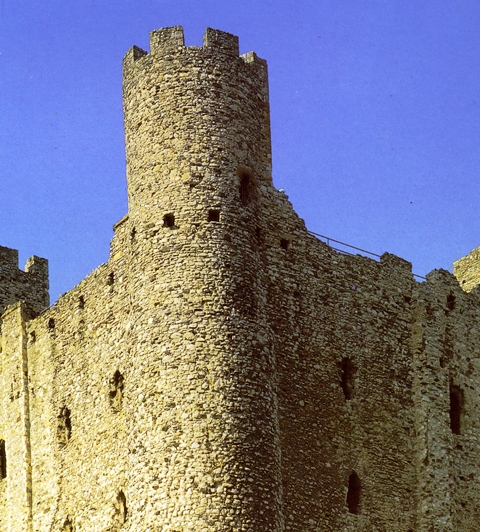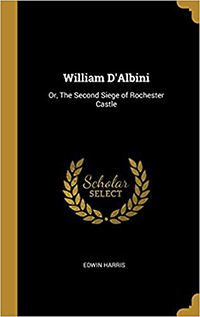Castle Stories
by James M Deem
Beaumaris Castle, Unfinished Masterpiece

Back to Main Castle Stories

Once there was an English king named John who had many enemies and many castles. Since he could not live in them all at one time, he had to leave other people in charge.  When he did, he hoped that he could trust them to remain loyal to him.
When he did, he hoped that he could trust them to remain loyal to him.
In the fall of the year 1215, John was at war with a number of rebels. He had left London and gone to the southeast, trying to put together an army to fight them. The rebels, though, had other plans. They established a headquarters in London. To stop John from returning to London with his army, they asked Stephen Langton, the man in charge of Rochester Castle, to turn it over to them. If they controlled Rochester Castle, the rebels believed that they could prevent John and his army from reaching London. Stephen Langton gave them the castle.
The rebels had about a hundred knights and many crossbowmen and men-at-arms. What they didn't have was much time to prepare the castle, for when they took charge of it, they found that it was not well supplied: there was no food in it. And because King John and his army were only a few miles away, they had just three days to stock it with supplies in order to prepare it for an attack--or a siege.
On September 30, the king sent his army to capture the bridge leading into Rochester, but they were beaten back. On October 11, the army surprised the rebels and crossed the bridge, surrounding the castle. Then they destroyed the bridge, effectively cutting the castle off from the rest of the rebel forces stationed in London. Reinforcements would never reach the rebels.
Two days later, on October 13, King John himself arrived and ordered five siege engines to be set up on Boley Hill, directly south of the castle. These machines hurled rocks at the castle nonstop for a number of days. At the same time, he ordered his crossbowmen to shoot at anything moving on the castle walls, and he sent his knights to attack the castle as well.
Many men died on both sides. But the rebels would not consider surrendering to a king they did not respect.
King John realized that the rock-throwing machines would never change the rebels' minds. So he decided to mine (that is, to dig underneath to help collapse) the castle walls. He ordered as many picks as possible be manufactured, so that the mines could be built quickly.
Wall-mining involved miners digging tunnels under the castle to weaken them. The tunnel roofs would be temporarily supported with timber beams. The tunnel would then be enlarged, directly beneath the wall foundation. When the tunnels were completed, they would be filled with brush and then set afire. As the brush burned, so would the support beams; eventually, the beams would give way and the weight of the foundation would cause the walls above to collapse into the tunnel.
Mining was a dangerous activity. The miners could hear the creaking support beams above them; they could collapse at any moment, crushing the miners or trapping them in an airless tunnel. And the rebels could hear the constant tapping and clanging of the miners' picks, day and night, but could do nothing to stop it.
When the miners' tunnel finally caused the castle wall to collapse, the kings' army stormed the castle. Most of the rebels, though, headed for the strongest building in the castle, the 110-foot-tall keep with its 12-foot thick walls.

So King John orders the miners to turn their attention to the southeast tower of the keep. They tunneled their way beneath the tower, hoping to cause a section of it to collapse and let the king's army capture the rebels inside.
As the miners completed their work, King John placed a special order: "We command that with all haste, by day and night, you send to us 40 bacon pigs of the fattest and those less good for the eating to bring fire under the tower."
The pigs were sent for and soon slaughtered. Their fat was used to coat the beams supporting the tunnel, ensuring a swift, hot fire. King John had used mining as a weapon against other castles he besieged, and had employed different techniques for building strong fires. But never had he used forty pigs to kindle the flames. It didn't matter; the forty pigs caused a roaring fire that helped King John succeed in bringing down the southeast tower.
The rebels, though, were full of surprises. Because the keep at Rochester Castle was so large, it had been divided in half when built. The rebels managed to lock themselves behind a dividing wall inside the opposite part of the keep.
By then, the siege had been going on for well over a month and some members of the rebel force, unable to fight, were sent outside in order to save food. They were welcomed by the king's army, but at least some of them were punished by having their hands and feet cut off.
Inside the keep, the rebels had little to live on. They had water, but no food--except a few horses. They killed their horses and ate the meat until they ran out. Finally, they surrendered on November 30, eight weeks after the siege had begun. Although King John was so angry that he wanted to hang every rebel, he was persuaded against this harsh punishment. It might make even more people hate him. So he decided to be lenient: he hanged only one crossbowman and imprisoned the rebel leaders in other castles around England.
He also tried to make sure that the next person left in charge of Rochester Castle was one that he could trust.


Copyright © James M. Deem. Taken from an unpublished manuscript by James M Deem. All rights reserved.

SOURCES
Brown, R. Allen. Castles. Princes Risborough: Shire, 1989.
Burke, John. The Castle in Medieval England. New York: Dorset, 1992.
Copeland, Tim. A Teacher's Guide to Using Castles. London: English Heritage, 1994.
_____. Rochester Castle. London: English Heritage, 1990.
Matarasso, Francois. The English Castle. London: Cassell, 1995.
McNeill, Tom. Castles. London: Batsford/English Heritage, 1992
Port, Graham. Rochester Castle. London: English Heritage, 1987.
Pounds, N.J.G. The Medieval Castle in England and Wales. Cambridge, Cambridge University Press, 1990.
